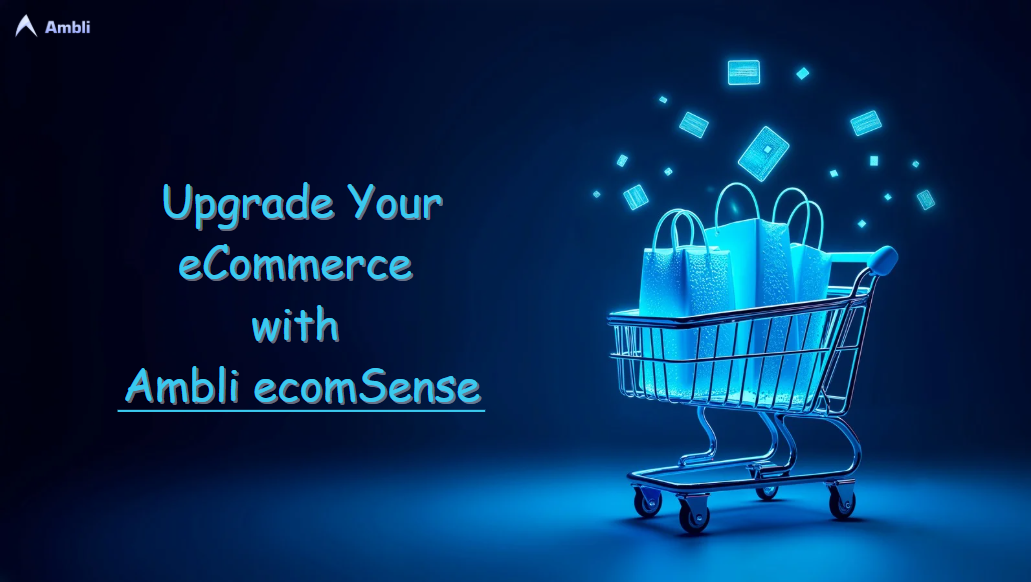How Ambli eComSense Is Changing the Way We Search on eCommerce Platforms!
Ambli
Author

Introduction : Why Most eCommerce Searches fail to achieve Expected Result
We all faced the same Problem —you know exactly what you want to buy, but the search bar just doesn’t understand it. You try different words, change words in your query, and scroll through dozens of useless results. After a few minutes, you either settle for something you didn’t want or leave the site altogether.
This small loss at the beginning of the shopping journey leads to unpleasant results for businesses. Lost sales. Irritated users. Increased support queries. And all because the search engine couldn’t understand what someone meant—only what they typed.
Search is not a technical feature nowadays. It’s a main part of user experience. And for modern customers who shop like they talk, old keyword-based systems just don’t work anymore.
That’s where Ambli eComSense comes in. It’s not about adding new filters or a good UI. It’s about rethinking how product discovery should work—with AI that understands human language, intent, and behavior.
Why Traditional Search Doesn’t work effectively Anymore
Most eCommerce platforms still use basic keyword matching. That means unless a shopper types the exact words that appear in a product description or tag, there are chances that the result will not be showcased.
For example, someone searching for a “rain jacket for running” may see casual monsoon coats, oversized windbreakers, or even kid’s wear. The engine fails to understand that the user likely needs a lightweight, easy to breathe, waterproof jacket suited for running.
These literal systems don’t understand:
- The user’s intent
- The occasion or context behind a search
- Common phrases or natural language
As a result, shoppers are forced to adjust their queries again and again, hoping to “speak the machine’s language.” That shouldn’t be necessary.
In today’s environment, where even a single pain point can send users switching to another site, the ability to understand how people think and search is critical.
Meet Ambli eComSense: A Better Way to Search
Ambli eComSense can do much more than just keyword matching. It’s an intelligent engine that uses Natural Language Processing (NLP), Machine Learning, and Visual Recognition to deliver results that actually match with what users mean—even when they don’t type perfectly.
Let’s break down what makes it different.
Understanding the True Intent Behind Search Queries
Unlike traditional systems, eComSense understands the structure and objective of a user’s search. If someone searches for “shoes for standing all day,” the engine doesn’t just show for the word “shoes”. It knows the user is likely looking for soft, orthopedic, or arch-support footwear.
It this by analyzing:
- Grammar
- Sentence structure
- Word relationships
- Contextual signals
So whether someone searches for “stylish office bag” or “formal laptop bag for women,” the results are aligned—not just with what was typed, but with what was the meaning.
Human-Like Conversations With Natural Language Search
People no longer search like machines. They type full sentences, ask questions, or describe situations. eComSense is made to handle natural queries like:
- “What can I give to a 13-year-old who loves science on birthday?”
- “I want something small for my home work space”
- “Shoes that look like Nike but cheaper”
This conversational style search shows how users naturally behave—and eComSense is designed to meet them where they are.
Personalized Results That Improves With Behavior
The more a user interacts with the platform, the better eComSense gets at showing them what they like. It adjusts based on:
- Past searches
- Products viewed or clicked
- Purchase history
- Time of day and seasonal trends
If a user shops for eco-friendly products again and again, eComSense can prioritize sustainability tags in results. If another prefers discounts, it highlights sale items first.
This kind of micro-personalization converts casual visitors into returning customers.
Visual Search: When You Don’t Know What It’s Called
Sometimes, shoppers can’t explain what they are looking for—but they’ve seen it.
eComSense includes a powerful Visual Search tool. A user can upload a photo of a bag they saw on social media, a chair from a coffee shop, or shoes of your friend which you liked so much. The system scans the image, identifies product features, and gives results for visually similar options.
This visual search uses advanced computer vision, allowing the user to skip boring typing entirely. Especially in industries like fashion, decoration or lifestyle this makes search smooth and even fun.
Smart Filters That Don’t Slow You Down
Traditional filtering systems do not change easily. You apply one filter, hit “apply,” wait for the page to reload, then try another.
With eComSense, filters update in real-time. As users clarify their selection—by color, price, size, rating, or brand—the results quickly adjust. This keeps users engaged and cuts down on effort.
These filters know the context too. If someone searches for “office wear for men,” eComSense automatically brings up filters relevant to formal clothing—like sleeve length, collar type, or fit—without needing manual setup.
This not only improves product finding but also reduces bounce rate remarkably.
A Day in the Life of eComSense
Let’s imagine a mid-size home décor brand launching a new eCommerce site. Their biggest struggle is a growing product catalog—over 10,000 items—and a rising number of customer complaints about not being able to find what they need.
With Ambli eComSense, the platform is transformed:
- Customers searching “sofa for studio apartments” now see small , foldable options instead of just big leather sofa sets.
- A user who types “lamps that match beige wall paint” gets suggestions with warm-coloured filters automatically applied.
- After adding a product to cart, real-time suggestions surface based on others who bought similar items.
Over time, this leads to more findings , more checkouts, and fewer left searches.
Why eComSense Outperforms Built-In Search Engines
While many platforms offer a basic search bar, they’re limited by old algorithms and rigid logic.
eComSense stands apart because:
- It understands full-sentence queries with intent instead of just keywords
- It adjusts to each user’s behavior and preferences
- It enables search by image, removing language as obstacle
- It delivers faster, real-time filter results
- It supports continuous learning and performance improvement through AI
In short, it’s not just a search bar—it’s an evolving system that gets smarter with every exchange of talk.
The Process: How To Get Started With eComSense
Implementing eComSense is a structured, collaborative journey:
1. Define the Problem
Do customers complain about search results? Are conversions lower than expected even with good traffic? Ambli helps identify search-related drop-offs and behavior trends.
2. Set the Scope
From catalog size to categories to personalization needs, Ambli tailors the engine setup to your brand’s exact needs.
3. Integrate via API
eComSense integrates smoothly into existing platforms, including Shopify, Magento, WooCommerce, and custom tech piles. No need to move or change your backend.
4. Launch & Optimize
Once live, the system continues to learn, adjust, and improve—guided by analytics and behavior feedback loops. Ambli provides ongoing support, model tuning, and user behavior reporting.
Frequently Asked Questions
How does eComSense know what users want if they’re vague?
It uses NLP to understand the query structure and analyze intent deeply . So even if someone types “something nice for parents,” the engine understands the situation and shows relevant ideas.
Is image search accurate?
Yes. The visual engine uses machine learning to match shapes, patterns, and color schemes. It’s especially useful for fashion and furniture where words can’t explain everything.
Can ecomSense understand multilingualism ?
eComSense can be trained to understand major Indian languages and local talk, depending on business needs.
Does personalization harm user privacy?
No. eComSense follows best practices for data security and anonymization. It personalizes based on behavior, not identity.
How long does integration take?
Basic setups can go live in 3–4 weeks. More difficult use cases with multiple storefronts or languages may take slightly longer.
Can this help reduce returns?
Yes. When users find exactly what they expected—thanks to smarter search—they’re less likely to return the product.
Conclusion: Better Search = Better Business
For shoppers, the search bar is often the first step in their journey.
If it doesn’t work well, the rest of the experience—no matter how beautiful the site or how good the products—doesn’t matter.
Ambli eComSense gives businesses the strength to transform that first step into a moment of clarity. One where the system truly understands what the customer means—not just what they type.
With features like natural language search, image-based discovery, smart filters, and behavior-driven personalization, eComSense turns search from an annoying problem into a helpful guide.
And for customers? It just feels like the website finally “understands” them.
References / Sources
https://www.ibm.com/cloud/learn/natural-language-processing
https://www.bigcommerce.com/blog/visual-search
https://blog.algolia.com/instant-search-ux
https://aws.amazon.com/rekognition
https://www.forrester.com/blogs/predictions-2024-retail-and-consumer-goods
